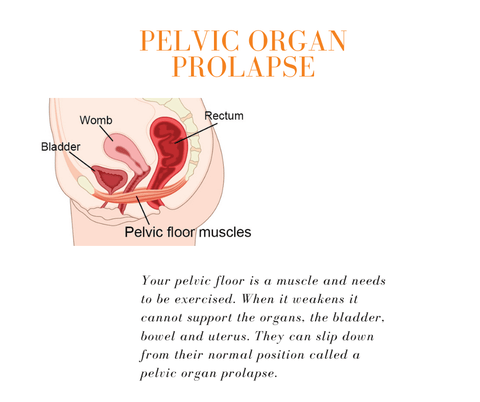The Ultimate Guide to Pelvic Prolapse and Exercise
Pelvic prolapse can be very painful and debilitating, and something that happens to many women as they age. In fact over 50% of women. Generally, it means there has been too much pressure on the internal organs, and things like childbirth, and hysterectomies, which many women will go through, add to the increase risk.
A pelvic organ prolapse can affect the bladder, uterus, or bowel and means that the internal organs involved have slipped down, from their natural position, and sometimes bulging through the anus or vagina, but not always. Symptoms can vary from nothing, with the prolapse being picked up during a routine smear test, for example, to a lot of pressure and pain in the lower pelvic region. Depending on the degree of the prolapse many women describe it as feeling like they are sitting on a tennis ball.

Exercise can help tone up the muscles of the pelvic floor, which potentially can prevent a prolapse; however, what happens once you already have a prolapse? Is exercise safe? In this guide, we take a look and discover what exercises are safe if you have a pelvic organ prolapse.
Can I Exercise with a Pelvic Floor Prolapse?
It is safe to exercise when you have a pelvic floor prolapse; however, you should make sure you perform exercises that are not going to add extra stress or put pressure on the organs involved. You should also try and vary your workout, so you are not spending the whole time standing up. Try and add seated exercises, and floor work lying on your side or your back.
Kegel exercises can be performed anywhere at any time and are one of the best ways to strengthen the pelvic floor, which will help with any existing prolapse or help prevent one from occurring. A guide to performing your Kegel exercises can be found here.
What Exercise Is Safe with a Prolapse?
It is worth bearing in mind that higher-impact exercises like jumping and running are not recommended while you have a prolapse. As well as putting extra strain on the area, you will find that bladder leakage can be a problem if you try and run while you have a prolapse. If you are not aware that you have a prolapse but suffer from bladder weakness or leakage when you do run, cough or sneeze, your body is signaling that your pelvic floor muscles are not as good as they could be, and you should work to strengthen them.
The best exercises for prolapse are lower-impact things like yoga, pilates, walking, cycling, swimming, using a cross trainer or taking a low-impact fitness class. If you are working with a trainer in a gym, make them aware of your condition, and they will help you ensure nothing in your routine is likely to worsen the problem.
Pelvic Floor Exercises for Prolapse
You will find that many of your favorite exercises can be modified to make them safe for pelvic prolapse. For example, weight training can be done in a seated position to avoid putting pressure on the pelvic region. If you perform squats, you need to make sure that they are lower and that you maintain a good posture throughout. Many yoga-style exercises are perfect for the pelvic floor.
Exercise #1: The Modified Plank

The plank is a very good one for strengthening all of the muscles around the core and pelvic area. However, the traditional plank would put a lot of pressure on the pelvic floor. So simply drop to your knees rather than balance on your toes when you perform the plank.
Exercise #2: Leg Raises

Begin on your hands and knees with your rests directly under your shoulders. Raise your left leg straight out behind you and, simultaneously, your right arm out in front. Hold for a count of five and return to the starting position now; swap to raise your right leg straight out behind you and your left arm at the same time.
Exercise #3: Balance on a Wobble Board

Wobble boards or Bosu balls are designed to work the balance, which involves the core muscles and the pelvic floor. Generally, a ball or platform that is uneven is used, and you need to stand unaided, balancing the platform, which will engage your core and pelvic floor muscles.
These are just some of the exercises that we run daily on our 28 Day Pelvic Floor Exercise challenge. If you want to be notified when we are running the next one you can enter your details here
If you want to get started straight away we do have a 4 Week Pelvic Floor Muscles Workout Programme. These videos are for you to keep and you can access them anytime and anywhere. All your workouts in one place.
Can Pelvic Floor Exercises Reverse Prolapse?
It really depends on how severe your prolapse is as to whether exercise can reverse it or not. Less severe prolapses can certainly be helped with exercise; however, if things have dropped too far out of place or even come through the anus or vagina, surgery may be required to reposition them. That said, it is never too late to start pelvic floor exercises if you have a mild prolapse or do not think you have any prolapse at this stage.
Ensuring that you keep your exercise within safe boundaries and avoid stressing the area too much are the best tools to ensuring the prolapse starts to reverse and doesn't get any worse. Kegel exercises are vital, and the beauty is that they can be done anywhere at any time. A great way to test the strength of your pelvic floor is a mid-urine stream test, where you clench your muscles to try and stem the flow of urine. If you can completely stop the urine, your pelvic floor is pretty good if it continues to flow; no matter how hard you clench, there is work to be done. Please only do this very infrequently as this can cause urinary infections. If you find Kegel exercises quite difficult, there are pelvic floor toner devices that can help you make sure you are doing your best to strengthen your pelvic floor and reverse any prolapse.
Start Your Pelvic Floor Exercises Now
A severe prolapse is not only frightening, but it can have a detrimental effect on your mental health. Even a mild prolapse can affect how you feel and how confident you are, especially if you have urine leakage. Starting your pelvic floor exercises is something you can do at any point in life, particularly after childbirth or having a hysterectomy or other procedure in the pelvic region. If you have any concerns about pelvic prolapse, you should consult your GP and ask to be referred to a pelvic floor physio..
To find out more, have a look at our other blogs:
Have I got a prolapse? Signs and symptoms explained.
Is it Too Late to Start Pelvic Floor Exercises?
A Step-By-Step Guide To Do Kegel Exercises
You can also join our fabulous womens only private Facebook Group
Fancy a freebie? Download our FREE guide The easy way to get a stronger pelvic floor
Any questions? Just email us at support@secretwhispers.co.uk and we will get straight back to you.










